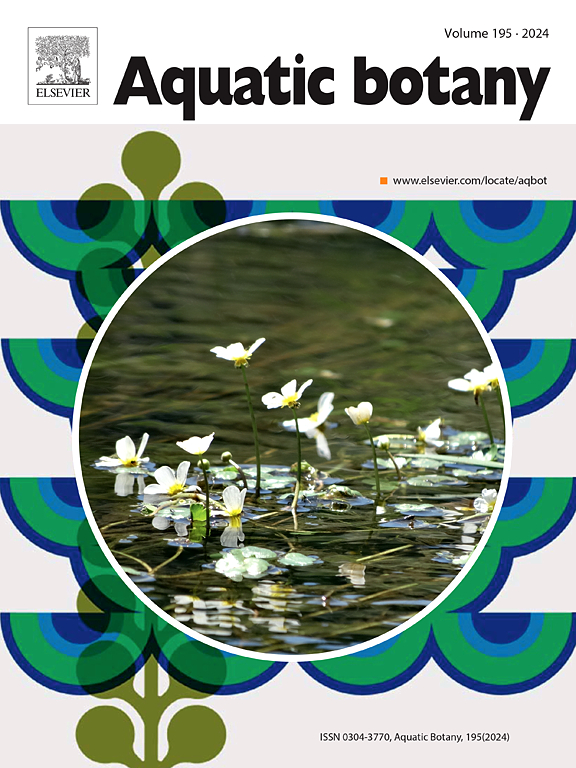The identification of abiotic stress by hydrogen peroxide concentration in submerged macrophyte tissues
IF 2.6
4区 生物学
Q2 MARINE & FRESHWATER BIOLOGY
引用次数: 0
Abstract
Submerged macrophytes in natural streams and stagnant waters are exposed to various abiotic stressors, including solar radiation, temperature fluctuations, and mechanical stress caused by water flow. During photosynthesis, carbohydrates are synthesized using electrons produced by absorbed solar radiation. However, surplus electrons, either due to excessive insufficient consumption, often caused by a lack of carbon dioxide (CO2) or inorganic carbon, can generate reactive oxygen species (ROS), leading to an increase in hydrogen peroxide (H2O2) concentrations. Consequently, the intensity of these stressors is often measured by the concentration of H2O2 in plant tissues. It's important to note that H2O2 production is not necessarily linked to a single stressor but can result from a combination of environmental factors. The primary objective of the tests was to determine how Myriophyllum spicatum responds to stress and produces H2O2 in reaction to flow patterns in streams and to high photosynthetically active radiation (PAR) in stagnant water. Observations were made at six stream sites. At each site, the flow velocity of the unidirectional mean flow (MV) and the turbulence velocity (TV) were measured within M. spicatum patches. In stagnant water, observations were conducted both in a moat where M. spicatum patches were located and in outdoor experimental tanks, where the plants were grown under controlled water temperatures and natural sunlight. Myriophyllum spicatum samples were collected alongside PAR measurements, and the H2O2 concentration in plant leaves was analyzed using the TiSO4 method. In streams, H₂O₂ concentrations were high in areas with very low turbulence. When turbulence reached sufficient levels, concentrations initially declined, then increased with further rising turbulence. In stagnant water, H₂O₂ concentrations, which were higher at elevated temperatures, increased proportionally with PAR intensity. In both scenarios, H₂O₂ levels decreased under extremely high stress, likely due to the deterioration of plant shoots. These results suggest that surplus electrons, arising from either limited electron consumption due to a restricted carbon source for synthesizing organic carbon or an excessive electron supply driven by strong PAR intensity, elevate H₂O₂ concentrations. However, with a sufficient carbon source available, H₂O₂ concentrations increase under heightened turbulence, likely as a result of mechanical stress.
利用过氧化氢浓度鉴定沉水植物组织中的非生物胁迫
天然溪流和死水中的沉水大型植物暴露于各种非生物应激源,包括太阳辐射、温度波动和水流引起的机械应力。在光合作用过程中,碳水化合物是利用吸收太阳辐射产生的电子合成的。然而,多余的电子,无论是由于过度消耗不足,通常是由于缺乏二氧化碳(CO2)或无机碳,可以产生活性氧(ROS),导致过氧化氢(H2O2)浓度的增加。因此,这些胁迫源的强度通常通过植物组织中H2O2的浓度来测量。需要注意的是,H2O2的产生并不一定与单一的压力源有关,而是由多种环境因素共同造成的。试验的主要目的是确定狐尾Myriophyllum spicatum如何对应激作出反应,并在溪流中的流动模式和滞水中的高光合有效辐射(PAR)下产生H2O2。在六个河流地点进行了观测。在每个站点,测量了棘突草斑块内的单向平均流速(MV)和湍流速度(TV)。在死水中,研究人员在有棘棘棘鼠斑块的护城河和室外实验池中进行了观察,在室外实验池中,植物在受控的水温和自然阳光下生长。收集细棘肉豆杉样品并进行PAR测量,采用TiSO4法分析植物叶片中H2O2浓度。在河流中,湍流非常低的地区,H₂O₂浓度很高。当湍流达到足够的水平时,浓度开始下降,然后随着湍流的进一步上升而增加。在滞水中,随着PAR强度的增加,H₂O₂浓度随温度升高而增加。在这两种情况下,在非常高的压力下,H₂O₂水平下降,可能是由于植物芽的退化。这些结果表明,由于合成有机碳的碳源有限,电子消耗有限,或者由于强PAR强度驱动的电子供应过多,导致多余的电子提高了H₂O₂浓度。然而,有了足够的碳源,在湍流加剧的情况下,H₂O₂浓度会增加,这可能是机械应力的结果。
本文章由计算机程序翻译,如有差异,请以英文原文为准。
求助全文
约1分钟内获得全文
求助全文
来源期刊

Aquatic Botany
生物-海洋与淡水生物学
CiteScore
3.80
自引率
5.60%
发文量
70
审稿时长
6 months
期刊介绍:
Aquatic Botany offers a platform for papers relevant to a broad international readership on fundamental and applied aspects of marine and freshwater macroscopic plants in a context of ecology or environmental biology. This includes molecular, biochemical and physiological aspects of macroscopic aquatic plants as well as the classification, structure, function, dynamics and ecological interactions in plant-dominated aquatic communities and ecosystems. It is an outlet for papers dealing with research on the consequences of disturbance and stressors (e.g. environmental fluctuations and climate change, pollution, grazing and pathogens), use and management of aquatic plants (plant production and decomposition, commercial harvest, plant control) and the conservation of aquatic plant communities (breeding, transplantation and restoration). Specialized publications on certain rare taxa or papers on aquatic macroscopic plants from under-represented regions in the world can also find their place, subject to editor evaluation. Studies on fungi or microalgae will remain outside the scope of Aquatic Botany.
 求助内容:
求助内容: 应助结果提醒方式:
应助结果提醒方式:


